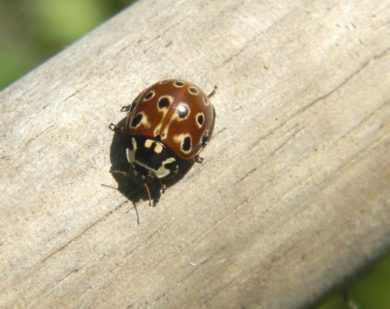We recognize the important role open data plays in furthering conservation goals and expanding scientific knowledge – it's why we created the Vermont Lady Beetle Atlas as a free public resource.

Eye-spotted Lady Beetle © Michael Clough
Our occurrence data is compiled from multiple sources: a historical publication from 1976, the Lost Ladybug Project, historic records and collections across from across Vermont, and any new species reported to the Vermont Atlas of Life (VAL) on iNaturalist.
You can explore and download our data by visiting VAL’s Integrated Publishing Toolkit. You can also view and download all records at the Vermont Lady Beetle Atlas on iNaturalist.
If you use this data, please cite us and send us a copy of the report or publication. Finally, data management takes time and money. Please consider supporting the atlas by making a donation to our parent project — the Vermont Atlas of Life.
Vermont Lady Beetle Atlas Progress Report
We just completed our first report on the data we have collected thus far! Over the last three years, community naturalist efforts to document Vermont’s current lady beetle fauna has yielded 2,707 research grade observations of 27 lady beetle species. Many of these great discoveries and contributions occurred between 2020 and 2021, when Vermont Lady Beetle Atlas efforts were expanded. Here are some of the highlights:
Species Rediscoveries:
Five species have been rediscovered:
– Bigeminate Sigil Lady Beetle (Hyperaspis bigeminata) – 2019
– Four-spotted Spurleg Lady Beetle (Brachiacantha quadripunctata) – 2020
– Octavia Lady Beetle (Hyperaspis octavia) – recorded for only the second time in Vermont in 2020
– Ten-spotted Spurleg Lady Beetle (Brachiacantha decempustulata) – 2021
– Hudsonian Lady Beetle (Mulsantina hudsonica) – 2021.
New Species Discoveries
In 2021, a lady beetle species, native to the eastern United States, was discovered in Vermont for the first time. During a bioblitz in Underhill, Vermont, VAL naturalist Nathaniel Sharp swung his net at a mysterious, small beetle and quickly realized he has captured someone interesting. After close examination in his home office, VAL director Kent McFarland had a tentative identification – a Disk-marked Lady Beetle (Hyperaspis disconotata). This ID was quickly confirmed, and Vermont’s number of recorded native species increased by one.
Non-native Species
Sadly, not all of our findings have been positive. Given the potential correlation between the introduction of non-native lady beetle species and the decline of native species, we have been monitoring the records of non-native species closely. Five non-native lady beetle species have been reported to iNaturalist since the start of the Atlas in 2019—Asian Lady Beetle (Harmonia axyridis), Fourteen-spotted Lady Beetle (Propylea quatuordecimpunctata), Seven-spotted Lady Beetle (Coccinella septempunctata), Variegated Lady Beetle (Hippodamia variegata), and Mexican Bean Beetle (Epilachna varivestis). In total, there were 1971 observations of these five species, which is 73 percent of the total lady beetle observations uploaded to iNaturalist from 2019 to 2021. We will continue monitoring these records over the coming field seasons to better understand these dynamics.






